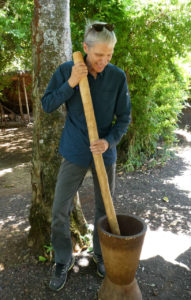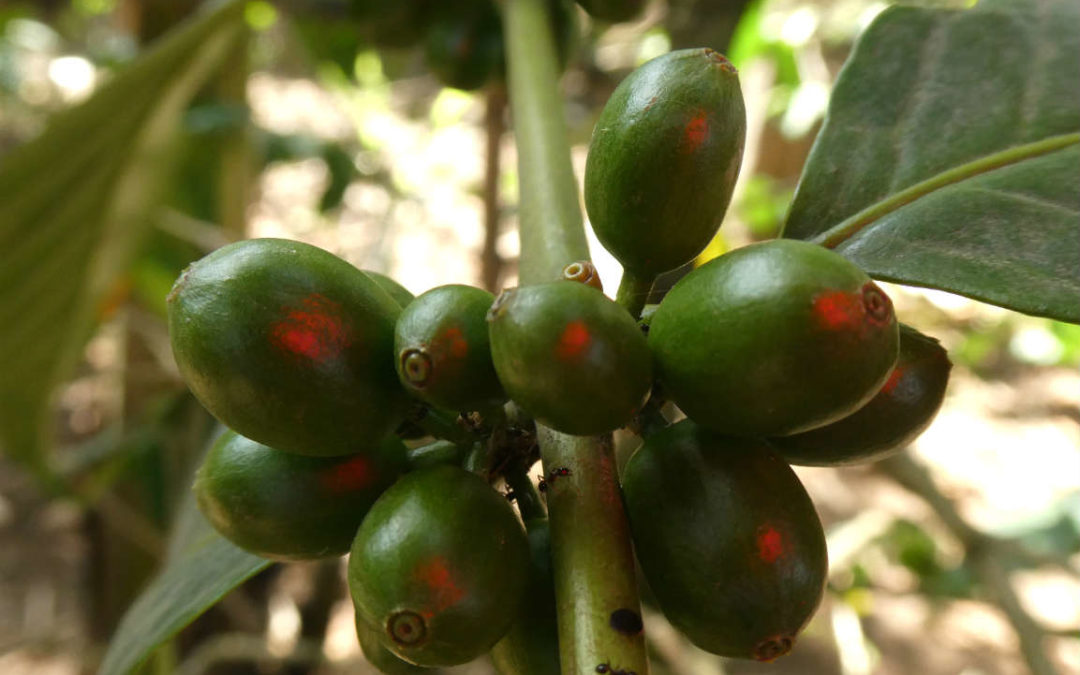Mt. Meru at almost 15,000 feet, the fifth highest mountain in Africa, capped in wispy clouds, towers over the Tanzanian village at the end of the paved road at the entrance to Arusha National Park. Meru’s taller and more well-known “mountain cousin”, Mt. Kilimanjaro, the highest peak on the African continent, bursts from the African plain only 216 miles as the crow flies east of Mt. Meru.
We stationed ourselves at Meru View Lodge, just one-half mile south of the Arusha National Park entrance to rest and recuperate in late January after a 24-hour travel day and 11-hour time zone difference from our Seattle home. Not wanting to miss any opportunity to learn more about Tanzania, I signed up for a walking tour with Abraham Mkope of Riziki Tours for a coffee tasting, Tanzanian lunch, and a walk in a neighboring forest preserve established to protect the local water supply. Trained as a civil engineer and being a lover of land and how it is used, curiosity drives me to experience how different cultures and countries build their communities. Touring the village at the end of the paved section of Momela Road opened my eyes to how differently people can live across the continents.
Leaving the Meru View Lodge with Abraham, we literally jumped across a two foot deep by 2-1/2 foot wide storm drainage swale lined with cemented in paving stones. Thankfully, January and February are typically drier months in Tanzania with the “long rains” or the rainy season beginning in March and lasting until May or June every year. With no rain in sight, these storm drains appeared excessively large, so I could only imagine the rushing water in the wet season. There must be a reason there is so much drainage capacity!

A Farm near Arusha, Tanzania
On an early Sunday morning, when many Tanzanians are in church, Abraham and I sauntered on the dusty dirt pathway adjacent to the paved road for a few minutes until crossing the weekend-quiet two-lane road. Our jaunt into the neighborhood on a rutted dirt road quickly changed to a dirt path. Sometimes we were caverned between concrete block walls and other times, surrounded by small farms, homes, and views of the countryside. In the hour walk to our destination, the terrain varied regularly between dirt roadway to narrow dirt pathways depending on the jigs and jags in our journey. Occasionally a motor cycle would scoot past, but mostly we walked alone in peace. Even the children were at church! Different land uses abounded. Small farms were tucked between homes, little wood and mud homes stood next to newer, larger half-finished brick homes. Occasionally we passed a completed home with a metal roof slathered with a white finishing material to conceal the brick building materials and a car parked out front. From a Seattle strict zoning code perspective, no sense of a land use plan was evident other than that there were no cul-de-sacs and always a path to follow. Some homes were only half finished and even looked forgotten or abandoned with a full grown banana tree in the foyer. Abraham said, “Villagers build their homes bit by bit as they earn extra money. Bank loans and mortgages are rare because reliable family income is not common.”
Small Farms in the Mt. Meru Region

Ripening Coffee Berries
Small farms, really almost large country garden plots, farmed by the neighboring homeowner dotted the landscape. Most families grow corn, more commonly known as maize, bananas and perhaps, Arabica coffee. Maize and bananas are the Meru region’s major crops as they are easy to grow and sell in local markets. Banana roots spread so easily, likely similar to the America’s raspberry bushes, and new banana trees just show up, hence the banana tree growing in the middle of an unfinished house. Despite being challenging to grow and sell, Arabica coffee is still an important export crop for the 400,000 family farmers that grow it. Tanzania is the 3rd largest coffee producer in Africa, but far below Brazil and Vietnam as the world’s biggest coffee producers. The Meru/Kiliminjaro region has the ideal Arabica coffee growing conditions between 4,500 and 6,000 feet above sea level with the rich volcanic soils. Despite this, Tanzanian coffee production has been significantly challenged by pests, climate change induced erratic weather conditions and just getting the crop to market.
After weaving our way between houses and farm plots, we arrived at our coffee stop where Sonia was waiting for us outside her parents’ home. The small, adobe finished home was compact and stout with the television dish on top. The home could have been easily found in an older American neighborhood! Sonia did not speak English, so Abraham led me through the 30-foot square family farm plot. Even though most of the ripe red beans had been harvested, there was still one stray white coffee flower and several handfuls of ripening berries on the bushes. The entire farm was protected from the equatorial sun with a smattering of banana trees and several taller trees providing shade for the coffee.
Producing a great cup of coffee takes time. After pollination, coffee berries grow into an oval shape about ½ inch in their longest dimension on chest high bushes. The berries start their life green and turn red when they are ready to be harvested by hand between July and December. All berries are air dried by Mother Nature on drying trays and rotated and turned to remove the fleshy portion of the bean leaving a thin almost fascia-like fibrous tissue covering on each bean. Each berry contains two beans unless there is only one bean, which happens only about 10% of the time, creating an extra special peaberry coffee and a premium price.

Grinding Coffee
Back in Sonia’s front yard, she brought out a couple cups of dried beans that still had the second covering or thin shell on them. Our first task was to remove the second shell. The beans were dropped into a huge mortar, an 8-inch diameter hollowed-out tree that stood about hip height. A 3-inch wide piece of aluminum flashing was secured to keep the “tree mortar” from splitting. The pestle was almost four feet tall and rounded on the bottom and made from another tree piece. Sonia pounded the beans loosening and shedding the second cover from the coffee bean. As the guest, I milled the beans for a few minutes until the pestle weight exhausted my arms!
The beans were dumped from the mortar and spread out on a woven platter. Abraham shook the platter lightly allowing the fibrous flakes to drift away with the breeze. Meanwhile Sonia started a small fire with dried twigs and branches. Perched on top of the flames was a small cast iron vessel into which she dropped the freshly cleaned beans. Stirring the beans regularly to prevent burning allowed the waft of freshly roasted beans to permeate the air.

Abraham Mkope removing the second shell from the bean.
Next step was putting the freshly roasted beans back into the mortar. The same pestle was used to grind the beans. We sang, “Saga, Saga–Saga” (Grinding, Grinding–Grinding) as the rhythmic song to ease the pain and monotony of a very physical method of coffee grinding! The ground coffee was sifted to separate the fine ground from the medium ground allowing an extra chance to grind all the coffee to a fine texture!
Now, the coffee is ground and the water is boiling. The grounds and the water are mixed to infuse flavor and caffeine. Sonia knew the optimal time to brew and poured it into my mug. I was offered sugar and put in a pinch since no milk available, to ward off any anticipated bitterness I was expecting. Wow! Was I amazed! No bitterness. My second cup was sugar free. The complexity of the flavor was stupendous!
Making a great cup of coffee took about 30 minutes. It is not a process for the caffeine craving morning wake-up routine but rather for enjoying a special time with good friends and family. No wonder my Ethiopian friend once said, “Being invited for coffee you know you are a true friend. Being invited for tea, not necessarily so.”
Kathryn Gardow, P.E., is a local food advocate, land use expert and owner of Gardow Consulting, LLC, an organization dedicated to providing multidisciplinary solutions to building sustainable communities. Kathryn has expertise in project management, planning, farmland conservation, and civil engineering, with an emphasis on creating communities that include food production. Kathryn’s blog muses on ways to create a more sustainable world and good food!

